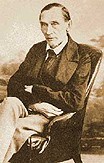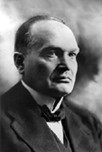The Estonian people have lived along the Baltic coast for about 1500 years, speaking a Finno-Ugric tongue closely related to Finnish and distantly removed from Hungarian. The people gained a reputation for trade and even naval warfare, as Estonian Vikings caused great damage to their Swedish counterparts during several centuries of mutual campaigns.
That all changed when Germanic forces arrived - under Papal assent - to wage a crusade against the "Baltic heathens" in the thirteenth century. Conversions - some voluntary, but mostly under duress or threat - happened over several decades until rebellions were all crushed and outside forces controlled all of Estonia.
Some eastern districts fell under the rule of Russian principalities, while Denmark also held certain northern parts, including Tallinn (derived from Taani linn, meaning "Danish town"). Though various religious and secular forces fought for control of the Baltic lands, in essence it began the rule of the region by the Baltic German aristocracy. However, many towns also flourished by being members of the Hanseatic League, the regional trade bloc.
Precipitated by the invasion of Russian forces, the Livonian political entity collapsed in the Livonian Wars of the latter half of the sixteenth century. Estonia eventually ended up under Swedish rule (in the north) and Polish-Lithuanian rule (in the south). In fact, the Polish red-white remains on several city symbols in the southern half of Estonia. Ensuing fighting left nearly all of present-day Estonia in the hands of the Swedish Kingdom in the early seventeenth century.
Many Estonians called the era under the Swedish Kingdom "the good old days" due to the benevolent policies of the Swedish monarchy. The institution known today as Tartu University was founded as the Kingdom's second institution of higher learning (after Uppsala), and Narva was under consideration to become a "second" capital of the Kingdom at one point.
However, the Great Northern War that broke out at the turn of the century brought calamity to the region. With a series of succession problems on the entire continent, the Baltic region became a scene of furious fighting for territory. The zenith of the Swedish Kingdom also passed, as the Baltic lands ended up in the hands of Russia's Peter the Great by 1710, and the Russian Tsar got his "window to the west."
Though Russia ruled the land, the Baltic Germans really controlled the territory. During Swedish rule, some of the rights of the Germanic nobility were quashed, pushing them closer to Russian influence - which was promptly rewarded when Russia took over the lands. However, the Baltic provinces became an experimental ground in some ways for the Russian Empire, with serfdom being abolished from the books decades before the rest of the Empire. However, that did little to alleviate the problems.
 |
| Friedrich Kreutzwald |
During the reign of Aleksandr III (1881-1894), a harsh policy of Russification took place. However, that also acted as a significant spark in the growth of the national movements in the region. Early leaders of the movement in Estonia, such as Johann Voldemar Jannsen and Jakob Hurt, played a significant role in the "national awakening" of Estonia, as did poetess Lydia Koidula and folklorist Friedrich Reinhold Kreutzwald - who compiled the national epic, Kalevipoeg.
Pushing for autonomy and more
Eventually, cultural awakening developed politically, and the debate then turned to the political future of the Estonian people. With the 1905 revolution in Russia, the population became agitated. As subsequent reforms in Tsarist Russia failed and the First World War broke out, leaders - such as Jaan Tõnisson and Konstantin Päts - now pushed for autonomy, or more. The 1917 revolutions in Russia, especially the latter Bolshevik revolution, pushed Estonians towards full independence.
A committee of Estonian political leaders declared the nation's independence on 24 February 1918, days after the same was done in Lithuania. However, chaos ensued as Bolshevik Russia pushed to take over the country. "White" Russian forces fought against the Bolsheviks and for the restoration of the Empire, and the German forces attempted to exert its influence as well. The War of Independence ensued.
With help from the allies - notably a symbolic arrival of a British naval squadron in Tallinn - the Bolsheviks failed to take Estonia. "White" Russian and Estonian forces pushed the Soviets back nearly to Petrograd (formerly St Petersburg), but the "White" Russian push failed. Eventually, a peace treaty was signed in Tartu; the document, the Tartu Peace Treaty, became known as Estonia's "birth certificate," as Russia pledged to respect the independence of Estonia forever. Ironically, it was, in a way, the "birth certificate" of the Soviet state as well, being the first real recognition by a foreign country.
On the other front, fighting against German forces was also fierce. Eventually, Estonian forces pushed the Landeswehr out of Estonia completely and helped the Latvians liberate their country from invaders as well. Estonia's Victory Day holiday (23 June) celebrates a crushing defeat of the German forces at today's Cēsis.
Alongside the fighting, the country's leaders organised elections for the constituent assembly in April 1919. A strong showing by leftist forces played a significant role in both land reform and the drafting of the constitution. The latter, modelled after the Weimar German document, kept nearly all power in the hands of the unicameral Riigikogu (Parliament). There was not even a president, with the head-of-state duties carried out by an emasculated prime-minister-like figure called the Riigivanem (State Elder).
Times of hardship
The early years of independence were difficult on the people, both in reform and in dealing with international affairs, especially debts. There was also an attempted Communist uprising sponsored by Moscow in 1924 that failed. The Communist Party was banned, though the threat always remained; symbolically as well, as the Soviet Union renamed a Russian border town after the Estonian Communist revolutionary Viktor Kingissepp. Economic woes also pushed the government to replace the currency, the mark, with a new currency in the late 1920s, the kroon, which was pegged to the Swedish currency.
With the world-wide depression, Estonia faced its own crunch due to trade disturbance. However, the unpopular devaluation of the kroon paved the way for quicker economic recovery. Unfortunately, several radical organisations became active - including one representing veterans of the War of Independence. Led by the charismatic orator, Artur Sirk, the organisation became the strongest political group in the land - and the new constitution they proposed, which created a powerful presidency among other provisions, won a resounding affirmation vote in referendum.
 |
| Konstantin Päts |
However, the caretaker Riigivanem at the time, the grand-old man of Estonian independence, Konstantin Päts, staged a "palace coup" in 1934 with the help of General Johan Laidoner. Päts explained that it was a "pre-emptive" move to prevent the radical veterans from gaining power. Estonia fell into a period called "the era of silence." During the next six years, Estonia was under a semi-authoritarian dictatorship, albeit on the mild side compared to its European counterparts. With the economy recovering and the endless bickering of the Riigikogu halted, people basically went about their own business.
However, as international affairs turned ominously dark in the latter half of the decade, Estonia was drawn into the fray. When Moscow and Berlin signed the infamous Molotov-Ribbentrop Pact that placed Estonia under Moscow's "sphere," its fate was essentially sealed. Hitler called for all Germans to repatriate, and they left - alongside "Germanised" Estonians.
Moscow forced Estonia and its neighbours to accept Soviet military bases, as Moscow accused Estonia of not being able to keep its neutrality, using the example of the escape of interned Polish submarine Orzeł. Eventually, an ultimatum was issued, and the occupation began in the summer of 1940. The world was preoccupied as Hitler marched into Paris that same week.
Soviet occupation
During the one-year Soviet occupation, thousands were killed and deported. The occupation forces staged a bogus election, after which the puppet regime "asked" Moscow for membership in the USSR, thus, the illegal incorporation. The United States and other Western governments announced then they would not recognise the move.
By the time Hitler and Stalin faced off in combat, the peoples of the Soviet-occupied lands - Estonia, Latvia, Lithuania, Ukraine, etc - were faced with the question of survival. So when the German army came through, it was viewed more as liberation from Soviet forces rather than a German occupation. However, the ensuing three years of German occupation in Estonia ended those hopes, with more brutal crackdowns by the Nazis. The Nazis even forcibly mobilised Estonians into combat units under the SS, though many joined voluntarily as well. Sad situations developed when brothers fought brothers during the period, as forcibly conscripted Soviet and Nazi forces faced off in bloody battles.
The Soviets retook Estonia and the Baltics in 1944 and bombed parts of the countries into the Stone Age. Historic Narva was all but destroyed. Ruins still dot the landscape, even in central Tallinn. The Soviets re-established control in Estonia, though armed resistance fighters - called metsavennad (the forest brothers) - fought bravely for years to come. Despite involvement by Britain's SIS and others, there was little assistance from the West except the "non-recognition" policy (the lack of Western response to the Hungarian 1956 uprising all but ended the movement).

|
The population of Estonia dropped from 88.2 per cent Estonian in 1934 to 61.5 per cent by 1989. Farms collapsed due to collectivisation, businesses were nationalised, Russian replaced Estonian as the official language of communications and everything associated with independent Estonia was all but oppressed by censors.
After decades of occupation, the seeds of the "national reawakening" were planted in the 1970s. One manifestation of public anger - in the form of youth angst - came in the punk movement and the banning of the band Propeller. The new generation, born after the death of Stalin, played a major role in the movement. Through the latter half of the 1980s, protesters supporting issues, such as the environment and historical accuracy, filled the streets. Using the shield of glasnost, movements for national issues were formed.
The rise of the Baltic tiger

Eventually, with more Esto-centric players in the Estonian Communist Party, the country began its break with the centre. Independence and anti-Communist activists also stepped up their efforts, and change became inevitable. A declaration of sovereignty was proclaimed in November 1988. Estonian was declared the official language, and pre-occupation symbols returned to public view. There was a movement against independence, mostly Russian-speaking activists backed by Moscow, but autonomy was already in place. One of the most spectacular protests came on the 50th anniversary of the Molotov-Ribbentrop Pact, in which people linked up in a human chain from Tallinn to Rīga to Vilnius in August 1989.
The first "free" elections to the Supreme Council were held in 1990, with pro-Estonia forces earning favourable results. An alternate body, elected only by registered citizens of Estonia (those who were citizens as of the occupation and their heirs), also formed the Estonian Committee. Estonia escaped the bloody January 1991 crackdowns that haunted Latvia and Lithuania. By then, the course was set, and nearly 80 per cent of all voters voted for independence in March 1991.
With the events in Moscow in August 1991, Estonia and its neighbours took advantage and asserted their
| Travelling to Estonia soon? Choose Hotels Central at HotelsEstonia.com to reserve a hotel online at a great price. |
Though times were hard and relations with Moscow difficult, Estonia became the "Baltic tiger," economically speaking, within a few years. The Estonian kroon (EEK) was once again introduced as the official currency in the summer of 1992, backed by Estonia's foreign assets - held in trust by the West during occupation, a legacy of the "non-recognition" policy. The 32-year old Mart Laar took over as Prime Minister, after the first Riigikogu elections, pushing "shock therapy" reforms to the maximum. The Russian military finally withdrew in August 1994, after lengthy and difficult negotiations.
Since then, Estonia has become a frontrunner in negotiations to join the EU, it has become a member of various organisations, such as the WTO, and was the first country from Central and Eastern Europe to preside over the Council of Europe in 1996.
Mel Huang, 10 July 2000
Moving on:
- Archive of articles on Estonia in CER
- Archive of articles by Mel Huang in CER
- Buy English-language books on the Baltics through CER
- Return to CER front page




